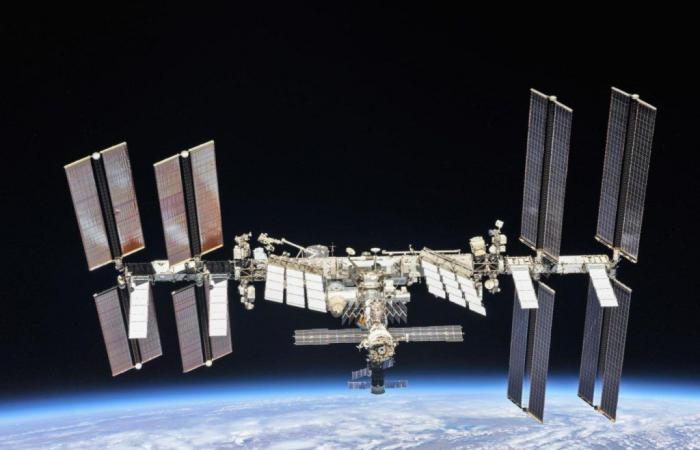Our good old International Space Station, which has played such an important role in science and diplomacy for over 25 years, will unfortunately not be around forever. Humanity’s space embassy will be retired for good at the beginning of the next decade, when a specially designed spacecraft will slow down its old carcass and send it burning up in the atmosphere. And NASA has finally announced the name of the contractor who will take care of it: it is SpaceX which inherited this heavy responsibility.
In a statement, the space agency announced that it had awarded a substantial envelope of 843 million dollars to Elon Musk’s company for the construction of this space hearse, named US Dehorbit Vehicle (USDV). A decidedly tidy sum for a device that is ultimately rather rudimentary, but nevertheless justified.
Indeed, dislodging the ISS from its orbit will not be a piece of cake. Since its commissioning, its mass has continued to increase, as new modules have been added. To date, it weighs approximately 420 tons, or the equivalent of about 340 standard cars. This is the heaviest and largest space structure ever built, and it will therefore take a rather muscular device to pull it towards its final resting place. However, SpaceX already has considerable expertise in the design of this type of machine, hence the fact that its proposal appealed to NASA.
It remains to be seen how USDV will leave Earth. Indeed, the wording of the press release suggests that this contract only concerns the tug itself, and not the vehicle which will be used to launch it. The latter will be the subject of another contract which has not yet been awarded by NASA. SpaceX is obviously one of the main contenders; its Falcon 9 and Falcon Heavy launchers could very well be responsible for sending the executioner of the ISS into orbit. But the agency could also select another launcher like the Vulcan Centaur, ULA’s new heavy launcher.
But in any case, SpaceX’s mission will end there. After design (or upon launch into orbit if it also inherits this contract), Elon Musk’s company will cede ownership and control of the vehicle to NASA. It is the agency’s operators who will be responsible for carrying out the mission itself.
A beautiful fireworks display in perspective
In practice, it will simply consist of docking the USDV to the station, then accelerating in the opposite direction of its orbit to slow it down. It will thus enter the atmosphere at more than 25,000 km/h, and will therefore be subjected to enormous mechanical and thermal constraints — with a sacred fireworks at stake.
According to NASA’s modeling, these forces will fracture the outpost into three pieces that will then disintegrate. Much of the structure will be completely pulverized, but many large pieces will not have time to burn completely, producing a large cloud of debris.
This is precisely why NASA planned this mission. By carrying out this maneuver at a very specific point in its orbit, it will be able to ensure that the corpse of the ISS will not represent a threat to populations and terrestrial infrastructure.
In this case, NASA intends to aim for Point Nemo — « person ” in Latin. As its name suggests, this is a very little-visited area of the Pacific Ocean, and for good reason: it is the point on Earth furthest from any land mass. For this reason, it is already a large satellite cemetery, and the venerable station will therefore rest alongside some of its illustrious ancestors in this aquatic tomb.
The other advantage of Point Nemo is that it is encircled by the South Pacific Gyre, a powerful circular current which isolates the region from a hydrological point of view. The area is therefore very poor in nutrients, and therefore very little frequented by animals. If the simple fact of sinking such a structure is obviously not ideal from an ecological point of view, this destination will at least limit the damage.
More than a station, a true symbol
Originally, it was Roscomos, the Russian space agency, which was to be responsible for deorbiting the ISS. But the situation completely changed with the invasion of Ukraine, which severely impacted relations between Putin’s country and the rest of the international community. Russia was ousted from several major programs like ExoMars, and in this context of hostility and uncertainty, the other partners preferred to ensure the transition themselves. A decision that is anything but anecdotal and even very representative of what awaits us after the station’s retirement.
Its primary role is to serve as a scientific outpost. At this level, other infrastructures will inevitably end up taking over, and there is no need to worry on that front. But the ISS is much more than just a scientific outpost. For many years now, it has represented a Neutral zone, an unshakeable ivory tower in geopolitical relations ; it plays a key role as a symbolic pretext, a common objective to maintain cooperation between nations.
This mission is all the more crucial today, in a context where the international community seems to be fracturing a little more each day. And unfortunately, This aspect will be much more difficult to replace..
Indeed, the status of space has changed enormously with the technological progress of the last few decades. In the past, it was a mysterious and inaccessible domain that forced the entire international community to advance hand in hand; but the explosion of the new space race is now pushing the various space powers, which are now much more autonomous, to advance each on their own in this new El Dorado of enormous strategic and economic importance.
We will therefore have to hope that the SpaceX hearse will only bury the structure itself, and that the ideal embodied by the ISS will survive this spectacular destruction.
-
-






